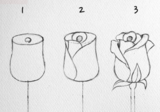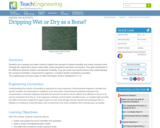
This resource includes countless downloadable step-by-step easy plant drawing lessons for kids.
- Subject:
- Arts Education
- Visual Arts
- Material Type:
- Activity/Lab
- Date Added:
- 06/07/2021

This resource includes countless downloadable step-by-step easy plant drawing lessons for kids.

Students practice creating rudimentary detail drawings. They learn how engineers communicate the technical information about their designs using the basic components of detail drawings. They practice creating their own drawings of a three-dimensional block and a special LEGO piece, and then make 3D sketches of an unknown object using only the information provided in its detail drawing.

Check out this site for how to draw instructions for these flowers: geranium, poppy, rose, calla lily, daffodil, tulip, sunflower, hydrangea, cosmos, apple blossom, snowdrops, and camellia.

Follow along with this quick YouTube video to create an amazing landscape pencil drawing. Plan to pause the video frequently to catch up.

Students use a compass and a permanent magnet to trace the magnetic field lines produced by the magnet. By positioning the compass in enough spots around the magnet, the overall magnet field will be evident from the collection of arrows representing the direction of the compass needle. In activities 3 and 4 of this unit, students will use this information to design a way to solve the grand challenge of separating metal for a recycling company.

There are countless drawing options for students to explore (animals, people, cartoon characters, objects, etc.) within this how-to-draw video collection.

After viewing and discussing two beds in the Getty's collection, students design and write descriptions of imaginary beds. Students will understand that everyday objects can be works of art, and that artists can design functional items that reflect their ideals of beauty.

This Super Lesson utilizes Project Based Learning to assist learners with designing, building, and testing flying contraptions as an introduction to Engineering. The goal of this project is to engage students in collaborative team work and to introduce students to the Science and Engineering Practices: Asking Questions and Defining Problems, Planning and Carrying Out Investigations, and Constructing Explanations and Designing Solutions.
We have offered this Super Lesson as an 8-week elective course, developing and strengthening student interest in applied Math and Science topics. It could also be offered within upper elementary or middle school Science and Math courses. In addition, each week’s topic could be used as a stand alone mini-lesson if time is limited. We have worked to include multiple options within this unit to make it accessible to both general education and special education programs, including recommendations for modifications and extensions.

This math problem demonstrates the concept of geometric progression, through an example of a million dollar contract between an employee and an employer. Application of the concept of geometric progression to social cause activism is addressed. This resource is from PUMAS - Practical Uses of Math and Science - a collection of brief examples created by scientists and engineers showing how math and science topics taught in K-12 classes have real world applications.

Students will examine primary sources in order to draw conclusions about the influence of Greek art and philosophy on the French Revolution. Students will compare the goals of the French Revolution to those of Neoclassical artists. Students will understand how visual language and style reflects underlying values in society by writing an analysis of the narrative in a work of art.

A tale about Bague and the stars from the Andes pleateau.

In this design activity, students investigate materials engineering as it applies to weather and clothing. Teams design and analyze different combinations of materials for effectiveness in specific weather conditions. Analysis includes simulation of temperature, wind and wetness elements, as well as the functionality and durability of final prototypes.

This activity is a teacher-led demonstration of continental drift and includes a math worksheet for students involving the calculation of continental drift over time. Students will understand what continental drift is, why it occurs, and how earthquakes occur because of it.

This problem involves fraction multiplication that can be solved with pictures or number lines.

This task builds on a fifth grade fraction multiplication task and uses the identical context, but asks the corresponding ŇNumber of Groups UnknownÓ division problem.

This task builds on a fifth grade fraction multiplication task and uses the identical context, but asks the corresponding ŇNumber of Groups UnknownÓ division problem.

This site teaches kids about the importance of safe drinking water through teaching and learning resources such as an activity on how to build your own aquifer, experiments on the water treatment process, and the drinking water art project.

Students use a sponge and water model to explore the concept of relative humidity and create a percent scale.

Taking a tour of the Driveline Baseball facility in Kent, WA! Walking through their weight room, batting and pitching cages, and covering some of the equipment and technology that is used to help with the development of their athletes/ clients.

The future is upon us. Brian & Darren talk about the growth of the auto-steer and autonomous tractor technology. Soon you could see a tractor without a driver on a farm near you.